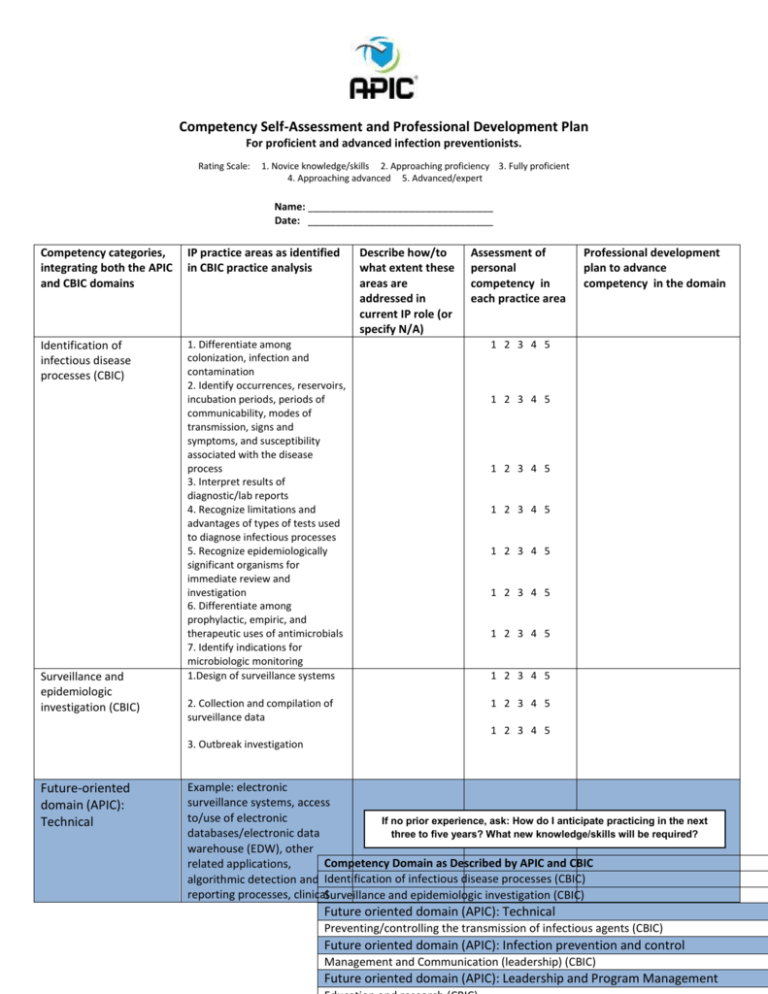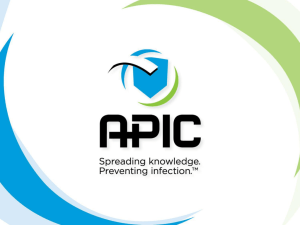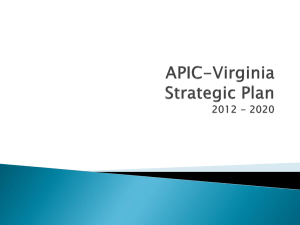
Competency Self-Assessment and Professional Development Plan
For proficient and advanced infection preventionists.
Rating Scale:
1. Novice knowledge/skills 2. Approaching proficiency 3. Fully proficient
4. Approaching advanced 5. Advanced/expert
Name: _________________________________
Date: _________________________________
Competency categories,
integrating both the APIC
and CBIC domains
IP practice areas as identified
in CBIC practice analysis
Identification of
infectious disease
processes (CBIC)
1. Differentiate among
colonization, infection and
contamination
2. Identify occurrences, reservoirs,
incubation periods, periods of
communicability, modes of
transmission, signs and
symptoms, and susceptibility
associated with the disease
process
3. Interpret results of
diagnostic/lab reports
4. Recognize limitations and
advantages of types of tests used
to diagnose infectious processes
5. Recognize epidemiologically
significant organisms for
immediate review and
investigation
6. Differentiate among
prophylactic, empiric, and
therapeutic uses of antimicrobials
7. Identify indications for
microbiologic monitoring
1.Design of surveillance systems
1 2 3 4 5
2. Collection and compilation of
surveillance data
1 2 3 4 5
Surveillance and
epidemiologic
investigation (CBIC)
Describe how/to
what extent these
areas are
addressed in
current IP role (or
specify N/A)
Assessment of
personal
competency in
each practice area
Professional development
plan to advance
competency in the domain
1 2 3 4 5
1 2 3 4 5
1 2 3 4 5
1 2 3 4 5
1 2 3 4 5
1 2 3 4 5
1 2 3 4 5
1 2 3 4 5
3. Outbreak investigation
Future-oriented
domain (APIC):
Technical
Example: electronic
surveillance systems, access
to/use of electronic
If no prior experience, ask: How do I anticipate practicing in the next
databases/electronic data
three to five years? What new knowledge/skills will be required?
warehouse (EDW), other
Competency Domain as Described by APIC and CBIC
related applications,
algorithmic detection and Identification of infectious disease processes (CBIC)
reporting processes, clinicalSurveillance and epidemiologic investigation (CBIC)
Future oriented domain (APIC): Technical
Preventing/controlling the transmission of infectious agents (CBIC)
Future oriented domain (APIC): Infection prevention and control
Management and Communication (leadership) (CBIC)
Future oriented domain (APIC): Leadership and Program Management
Competency Self-Assessment and Professional Development Plan
For proficient and advanced infection preventionists.
Rating Scale:
1. Novice knowledge/skills 2. Approaching proficiency 3. Fully proficient
4. Approaching advanced 5. Advanced/expert
decision support, infection
prevention within the
electronic health record
Preventing/controlling
the transmission of
infectious agents (CBIC)
Future-oriented
domain (APIC):
Infection prevention
and control
1. Develop and review infection
prevention and control policies
and procedures
2. Collaborate with public health
agencies in planning community
responses to biologic agents
3. Identify and implement
infection prevention and control
strategies according to specific
topics:
Hand hygiene
Cleaning, disinfection
and sterilization
Specific direct and
indirect care settings
Therapeutic and
diagnostic procedures
and devices
Product/equipment
recall procedures
Use of solation/barrier
precautions when
indicated
Patient placement,
transfer, discharge
Environmental hazards
Use of patient care
products and medical
equipment
Patient immunization
programs
Construction and
renovation
Influx of patients with
communicable diseases
1 2 3 4 5
1 2 3 4 5
1 2 3 4 5
1 2 3 4 5
1 2 3 4 5
1 2 3 4 5
1 2 3 4 5
1 2 3 4 5
1 2 3 4 5
1 2 3 4 5
1 2 3 4 5
1 2 3 4 5
1 2 3 4 5
1 2 3 4 5
1 2 3 4 5
Examples: ability to apply and
use surveillance data and
If no prior experience, ask: How do I anticipate practicing in the next
reports, advanced statistical
three to five years? What new knowledge/skills will be required?
methods and tools, including
application of the standard
Competency Domain as Described by APIC and CBIC
infection ratio, risk
Identification of infectious disease processes (CBIC)
assessment, hazard
Surveillance and epidemiologic investigation (CBIC)
vulnerability analysis, use and
evaluation of emerging Future oriented domain (APIC): Technical
Preventing/controlling the transmission of infectious agents (CBIC)
Copyright © 2013 by the Association for Professionals in Infection
and Epidemiology,
Inc. (APIC)
All rights reserved.
Intendedand
for personal
FutureControl
oriented
domain (APIC):
Infection
prevention
control
use only. No part of this publication may be reproduced, stored in a retrieval system, or transmitted, in any form or by any means, electronic,
Management
and
Communication
(leadership)
(CBIC)
mechanical, photocopied, recorded or otherwise, without prior written permission of the publisher.
Future oriented domain (APIC): Leadership and Program Management
Education and research (CBIC)
Future oriented domain (APIC): Performance Improvement and Implementation
Employee/occupational health (CBIC)
Competency Self-Assessment and Professional Development Plan
For proficient and advanced infection preventionists.
Rating Scale:
1. Novice knowledge/skills 2. Approaching proficiency 3. Fully proficient
4. Approaching advanced 5. Advanced/expert
prevention practices for
patient care, diagnostic
methods, participation in
antimicrobial stewardship
programs
Management and
communication
(leadership) (CBIC)
Future-oriented
domain (APIC):
Leadership and
program management
Education and research
(CBIC)
1.Planning
1 2 3 4 5
2.Communication and feedback
1 2 3 4 5
3.Quality/performance
improvement and patient safety
1 2 3 4 5
Examples: leads integration of
prevention activities within
and across departments, high
level negotiation skills,
financial/value analysis of
If no prior experience, ask: How do I anticipate practicing in the next
programs and related projects,
three to five years? What new knowledge/skills will be required?
relationship management,
ability to influence and
Competency Domain as Described by APIC and CBIC
persuade up to and including
Identification of infectious disease processes (CBIC)
executive level, team and
Surveillance and epidemiologic investigation (CBIC)
consensus building within and
Future oriented domain (APIC): Technical
across stakeholder groups
Preventing/controlling the transmission
1 2 3 4of 5infectious agents (CBIC)
1.Education
Future oriented domain (APIC): Infection prevention and control
2. Research
1 2(leadership)
3 4 5
Management and Communication
(CBIC)
Future oriented domain (APIC): Leadership and Program Management
Education and research (CBIC)
Future oriented domain (APIC): Performance Improvement and Implementatio
Employee/occupational health (CBIC)
Future-oriented
domain (APIC):
Performance
Improvement and
Implementation
Science
Employee/occupational
health (CBIC)
Examples: leads performance
improvement (PI) teams for
If no prior experience, ask: How do I anticipate practicing in the next
institution/system, develops
three to five years? What new knowledge/skills will be required?
interprofessional
competencies, applies
Competency Domain as Described by APIC and CBIC
translational research
methods, uses advanced PI Identification of infectious disease processes (CBIC)
tools/methods, focus on Surveillance and epidemiologic investigation (CBIC)
reliability and sustainability Future oriented domain (APIC): Technical
1 2 3 4of 5infectious agents (CBIC)
1.Review and/or develop Preventing/controlling the transmission
screening and immunizationFuture oriented domain (APIC): Infection prevention and control
programs
Management and Communication (leadership) (CBIC)
2.Proivde counseling, followFuture oriented domain (APIC): Leadership and Program Management
Education and research (CBIC)
Copyright © 2013 by the Association for Professionals in Infection Control and Epidemiology, Inc. (APIC) All rights reserved. Intended for personal
Future
oriented
(APIC):
Improvement
and
use only. No part of this publication may be reproduced, stored
in a retrieval
system, domain
or transmitted,
in any Performance
form or by any means,
electronic,
mechanical, photocopied, recorded or otherwise, without prior
written permission of the publisher.
Employee/occupational
health (CBIC)
Implementatio
Competency Self-Assessment and Professional Development Plan
For proficient and advanced infection preventionists.
Rating Scale:
1. Novice knowledge/skills 2. Approaching proficiency 3. Fully proficient
4. Approaching advanced 5. Advanced/expert
up, work restriction
recommendations related to
communicable diseases or
following exposures
3.Assist with analysis and
trending of occupational
exposure incidents and
information exchange
between occupational health
and infection prevention and
control departments
1 2 3 4 5
1 2 3 4 5
Assumptions:
Once CBIC certification has ben achieved, competency is highly individualized and technically complex. It
is driven by multiple factors, including educational opportunities, practice setting, and personal interests.
Because competency is highly personalized and develops across the career span, no infection
preventionist (IP) is expected to be “advanced” in most/all areas at any particular time. The goal is to
identify areas for individual improvement so that professional development becomes a lifelong endeavor.
The core competencies identified by CBIC and the future oriented domains added by APIC are
complementary and not mutually exclusive categories. By integrating them into one comprehensive selfassessment, the IP will be better prepared to address both immediate and evolving professional demands.
Core competencies as identified by CBIC remain relevant across the career span but their implementation
evolves as proficiency increases. Therefore, assessment of core competencies for proficient and advanced
IPs focuses on how these skills are applied and the extent to which the IP is able to utilize them to foster
program development and to assist others in their prevention efforts.
The future-oriented domains described by APIC build on the core competencies. The content may at times
appear to overlap. However, the future oriented domains attempt to identify those skills not yet included
in the CBIC practice analysis but which, based on observation and professional consensus, are expected to
be essential for IP practice in the next three to five years.
Copyright © 2013 by the Association for Professionals in Infection Control and Epidemiology, Inc. (APIC) All rights reserved. Intended for personal
use only. No part of this publication may be reproduced, stored in a retrieval system, or transmitted, in any form or by any means, electronic,
mechanical, photocopied, recorded or otherwise, without prior written permission of the publisher.








